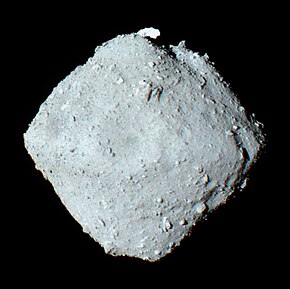Our website is made possible by displaying online advertisements to our visitors.
Please consider supporting us by disabling your ad blocker.
162173 Ryugu
 Color image of Ryugu taken by Hayabusa2, 2018 | |
| Discovery[1] | |
|---|---|
| Discovered by | LINEAR |
| Discovery site | Lincoln Lab's ETS |
| Discovery date | 10 May 1999 |
| Designations | |
| (162173) Ryugu | |
| Pronunciation | /riˈuːɡuː/ Japanese: [ɾjɯːɡɯː] |
Named after | Ryūgū[1] ("Dragon palace") |
| 1999 JU3 | |
| Apollo · NEO · PHA[1][2] | |
| Orbital characteristics[2] | |
| Epoch 12 December 2011 (JD 2455907.5) | |
| Uncertainty parameter 0 | |
| Observation arc | 30.32 yr (11,075 d) |
| Aphelion | 1.4159 AU |
| Perihelion | 0.9633 AU |
| 1.1896 AU | |
| Eccentricity | 0.1902 |
| 1.30 yr (474 d) | |
| 3.9832° | |
| 0° 45m 34.56s / day | |
| Inclination | 5.8837° |
| 251.62° | |
| 211.43° | |
| Earth MOID | 0.0006 AU (0.2337 LD) |
| Physical characteristics | |
| Dimensions | 1004 m × 876 m[3] |
| 448±2 m[3] | |
Equatorial radius | 502±2 m[3] |
Polar radius | 438±2 m[3] |
| Volume | 0.377±0.005 km3[3] |
| Mass | (4.50±0.06)×1011 kg[3][4] |
Mean density | 1.19±0.03 g cm−3[3] |
Equatorial surface gravity | 1/80,000 g[4] |
| 7.63262±0.00002 h[3] | |
| 171.64°±0.03°[3] | |
North pole right ascension | +96.40°±0.03°[3] |
North pole declination | −66.40°±0.03°[3] |
| 0.037±0.002[5] 0.042±0.003[6] 0.047±0.003[7] 0.063±0.020[8] 0.07±0.01[9] 0.078±0.013[10] | |
| SMASS = Cg[2] · C[7] · Cb[11] | |
| 18.69±0.07 (R)[10] 18.82[8] 19.2[5] 19.25±0.03[7] 19.3[1][2] | |
162173 Ryugu (provisional designation 1999 JU3) is a near-Earth object and also a potentially hazardous asteroid of the Apollo group. It measures approximately 900 metres (3,000 ft) in diameter and is a dark object of the rare spectral type Cb,[11] with qualities of both a C-type asteroid and a B-type asteroid. In June 2018, the Japanese spacecraft Hayabusa2 arrived at the asteroid.[12] After making measurements and taking samples, Hayabusa2 left Ryugu for Earth in November 2019[13][14] and returned the sample capsule to Earth on 5 December 2020.[14] The samples showed the presence of organic compounds, such as uracil (one of the four components in RNA) and vitamin B3.
- ^ a b c d Cite error: The named reference
MPC-objectwas invoked but never defined (see the help page). - ^ a b c d Cite error: The named reference
jpldatawas invoked but never defined (see the help page). - ^ a b c d e f g h i j k Cite error: The named reference
Watanabe et al. 2019was invoked but never defined (see the help page). - ^ a b Cite error: The named reference
SpaceFlightNowwas invoked but never defined (see the help page). - ^ a b Cite error: The named reference
Abe-2008was invoked but never defined (see the help page). - ^ Cite error: The named reference
Liang-liang-2014was invoked but never defined (see the help page). - ^ a b c Cite error: The named reference
Muller-2017awas invoked but never defined (see the help page). - ^ a b Cite error: The named reference
Hasegawa-2008was invoked but never defined (see the help page). - ^ Cite error: The named reference
Campins-2009bwas invoked but never defined (see the help page). - ^ a b Cite error: The named reference
Kim-2013was invoked but never defined (see the help page). - ^ a b Sugita, S.; Honda, R.; Morota, T.; Kameda, S.; Sawada, H.; Tatsumi, E.; Honda, C.; Yokota, Y.; Yamada, M.; Kouyama, T.; Sakatani, N. (July 2019). "Ryugu's Parent-Body Processes Estimated from Hayabusa2 Multi-Band Optical Observations". 82nd Annual Meeting of The Meteoritical Society, held 7-12 July, 2019 in Sapporo, Japan. LPI Contribution. Vol. 2157. p. 6366. Bibcode:2019LPICo2157.6366S. ISSN 0161-5297.
{{cite book}}: CS1 maint: date and year (link) - ^ Chang, Kenneth; Stirone, Shannon (19 March 2019). "The Asteroid Was Shooting Rocks Into Space. 'Were We Safe in Orbit?'". The New York Times. Retrieved 21 March 2019.
NASA's Osiris-Rex and Japan's Hayabusa2 spacecraft reached the space rocks they are surveying last year, and scientists from both teams announced early findings on Tuesday.
- ^ Stephen Clark (13 November 2019). "Japanese sample return craft departs asteroid, heads for Earth"./
- ^ a b Cite error: The named reference
NYT-20201205was invoked but never defined (see the help page).
Previous Page Next Page


